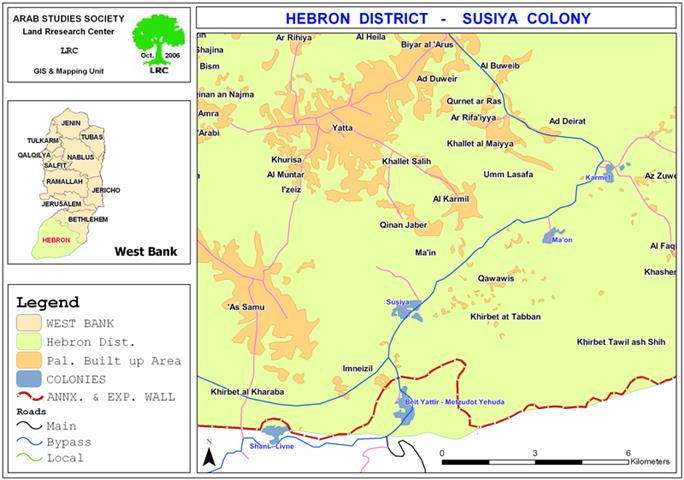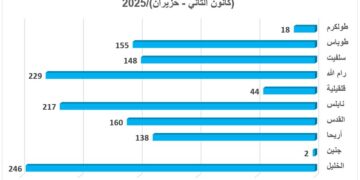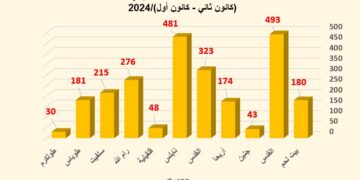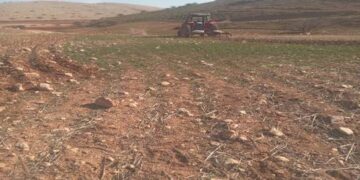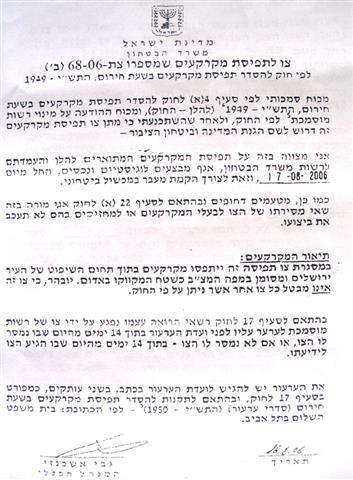There are four settlements located to the south of Yatta town in Southern Hebron governorate on road number 317. These settlements are lived by most extremist Jewish settlers who continue to attack Palestinian citizens, land and properties. The following table gives information about these four settlements: See Table 1 and Map 1 below
Table 1: settlements established on southern Yatta land
|
Settlement name |
Date of establishment |
Population in 2004 |
Built up area |
Municipal area |
|
Karmel |
1981 |
319 |
177 |
1758 |
|
Ma'on |
1981 |
308 |
173 |
303 |
|
Susiya |
1983 |
663 |
352 |
1546 |
|
Mezadot Yehuda ( Beit Yattir) |
1980 |
425 |
170 |
2817 |
|
Total |
|
1715 |
872 |
6424 |
Source: Foundation for Middle East Peace.
In last September, the Israeli settlers committed the following aggressive acts:
1. Taking over of 150 dunums of land
Settlers from Suisiya settlement took over about 150 dunums from the Palestinian owned land in the southern side of the settlement. The settlers plowed the land and planted it with fruitful trees.
Land owners and farmers from the area confirmed to LRC field worker that settlers from the aforementioned settlement had prevented them from reaching their land. Then, they plowed it under the protection of the Israeli soldiers and planted it with almond, olive and forest trees.
The target land is owned by many Yata families of which the following has been known: Abu Sabha, Shamisti and Sha'abin. The land has been mainly used by its owners for mainly two purposes: firstly, for the production of seasonal crops, such as cereals ( wheat, barley and lentil), and , secondly, as a grazing zones for local herds.
2. Enlargement of cow farm
In related development, settlers began to enlarge a cow farm located in Um Zaytuna area between the settlements of Karmel and Maon. Local people informed LRC field worker that Israeli bulldozers are working day and night in the enlargement of the cow farm south ward at the expense of the land of the Yata Family of Abu 'Iram. Cement basis and floors are now under construction as a preparation for the provision of additional barracks and sections. The farm was initially established 15 years ago and started to gradually expand over adjacent Palestinian land.
3. Settlement expansion completed
A ten flat settlement expansion has been completed at the southern edge of Karmel settlement in Yata region, Hebron governorate. The new expansion project started three years ago under strict and continuous army protection with the aim of forcing new realities on the ground. The new expansion was built over 50 dunums of land owned by Mr. Yamin Al Hazalin who submitted many complaints to the Israeli courts, including the supreme court, but to no avail.
Photo 1: The settlement of Karmel

Photo 2: The ten flats recently completed and attached to the settlement of Karmel
Photos courtesy of LRC
4. Settlers threatened internationals accompanying shepherds
Wednesday, Sep. 6: At 8.30 AM, a Dove and CPTer were accompanying a shepherd from Maghayir al Abeed. At around 10 AM, when the shepherd already left, two settler men came down the hill toward the internationals. They threatened them, saying, 'If you don't leave, we will put your head against the stone.' No one was hurt. They recorded the incident on videotape.
12 pm, A CPT went to Kiryat Arba'a police station to report the threat. The police said they couldn't do anything because the settler did not speak in good enough English, so the court wouldn't convict if they prosecuted. The CPTer left a copy of the videotape with the police in case they have further questions. ( source: Operation Dove).
5. Susya settlers strewed metal spikes on the road and damaged a water truck
Tuesday, Sep. 12: 3.30 PM, a man reported that the truck carrying Oxfam water to Khirbet Susiya had gotten 5 flat tires because there were metal spikes strewn onto the road into the village by settlers from Susiya settlement. He brought with him three spikes to show to the Dove and CPT team. ( source: Operation Dove).
6. Settlers came close to At Tuwani and threatened a villager
Wednesday, Sep. 13: At 7 AM, the Dove and CPT team got a call from a villager. He reported that 6 settlers were on the hill behind his house. Four had come through the gate, two down from the trees. When they saw the Palestinian man they threatened him, then left. By the time the team responded, the settlers were out of sight.
10.40 AM, the driver of the water truck who had encountered the spikes on the road yesterday came by with some more of the spikes. The team met with him about 20 minutes. He said that as he was collecting the spikes, 4 settler women (presumably from Suseya) were looking on. He knows of an iron factory that serves the settlement not far away, where the spikes could have been made. He said that he did deliver the water ultimately yesterday. He did not notify the police, as the experience in the community is that they never are helpful in investigating these situations. (source: Operation Dove).
Map prepared by LRC GIS unit
7. Seven settlers attacked a man from Khirbet Susiya, accompanying soldiers did not interfere
Monday, Sep. 18: At 5.20 PM, CPT and Doves receive a call that a man from Khirbet Susiya has been attacked by settlers. CPTer traveled with a Ta'ayush ( Co-existence Israeli peace groups) member there, arriving at 6:00 pm. The man, 70, was not far from his tent when attacked by seven masked Israeli settlers, accompanied by a soldier who did nothing to prevent the attack. The villagers called the police, but could not get a response. They then called the Israeli Ta'ayush member, who called the police on their behalf, and asked them to investigate. Police were at the scene when the CPTer arrived, taking a report. Military showed up thirty minutes later. Some of the soldiers were upset that the CPTer was videotaping, and discussed amongst themselves stopping him. They left shortly after. The Israeli man asked the military to open the gate to the old Palestinian road to Yatta, to allow shorter distance for the ambulance, but the soldiers refused. He took the responsibility to open the gate himself and allowed the Red Crescent ambulance through. Red Crescent health workers gave the man a check up, and took him by ambulance to Yatta.
The man was beaten with sticks and pipes, and suffered from blows to his leg, arm, hand, wrist, and upper body. It was later determined that the man sustained no major injuries or broken bones. (source: Operation Dove).
Prepared by
The Land Research Center
LRC


